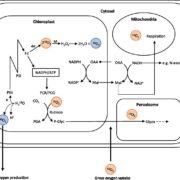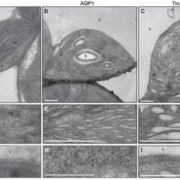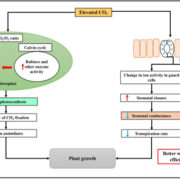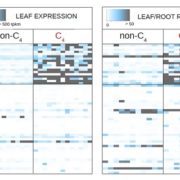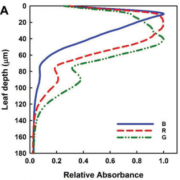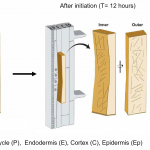Structural organization of the spongy mesophyll (New Phytol.)
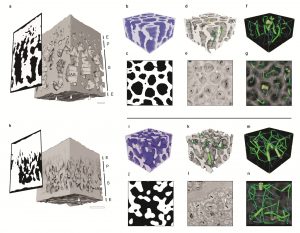 Despite a large variation in leaf morphology, laminar leaf anatomy is largely conserved, comprising two developmentally distinct mesophyll tissues, the palisade and spongy mesophyll. Spongy mesophyll cells along with intercellular spaces form an interconnected network to maximize the surface area for light capture and gas exchange. However, the structural organization of spongy mesophyll is relatively understudied due to the technical limitations of deep tissue imaging. Borsuk et al. analysed the 3D cellular geometry of spongy mesophyll in 40 species belonging to 30 genera using X-ray micro- computed tomography imaging. Contrary to the general perception of the spongy mesophyll as a random assembly of irregularly shaped cells, the authors observed two divergent phenotypes – the honeycomb and the non-honeycomb topology. The plants with honeycomb topology have larger cells, lower mesophyll surface area per unit volume (SAmes/Vmes) and lesser maximum photosynthetic rate (Amax). However, the honeycomb tessellation satisfies the multi-functional demands with economical construction costs, which suggests that two distinct topologies are optimized for either photosynthetic performance or minimal resource investment. The authors highlight flow rate directionality, cell arm length, cell packing density, and the characteristic minimum vein spacing as important structural drivers of the spongy mesophyll. This study shows that the structural organization of spongy mesophyll is a key trait influencing the leaf economy. (Summary by Prakshi Aneja @PrakshiAneja) New Phytol. 10.1111/nph.17971
Despite a large variation in leaf morphology, laminar leaf anatomy is largely conserved, comprising two developmentally distinct mesophyll tissues, the palisade and spongy mesophyll. Spongy mesophyll cells along with intercellular spaces form an interconnected network to maximize the surface area for light capture and gas exchange. However, the structural organization of spongy mesophyll is relatively understudied due to the technical limitations of deep tissue imaging. Borsuk et al. analysed the 3D cellular geometry of spongy mesophyll in 40 species belonging to 30 genera using X-ray micro- computed tomography imaging. Contrary to the general perception of the spongy mesophyll as a random assembly of irregularly shaped cells, the authors observed two divergent phenotypes – the honeycomb and the non-honeycomb topology. The plants with honeycomb topology have larger cells, lower mesophyll surface area per unit volume (SAmes/Vmes) and lesser maximum photosynthetic rate (Amax). However, the honeycomb tessellation satisfies the multi-functional demands with economical construction costs, which suggests that two distinct topologies are optimized for either photosynthetic performance or minimal resource investment. The authors highlight flow rate directionality, cell arm length, cell packing density, and the characteristic minimum vein spacing as important structural drivers of the spongy mesophyll. This study shows that the structural organization of spongy mesophyll is a key trait influencing the leaf economy. (Summary by Prakshi Aneja @PrakshiAneja) New Phytol. 10.1111/nph.17971


